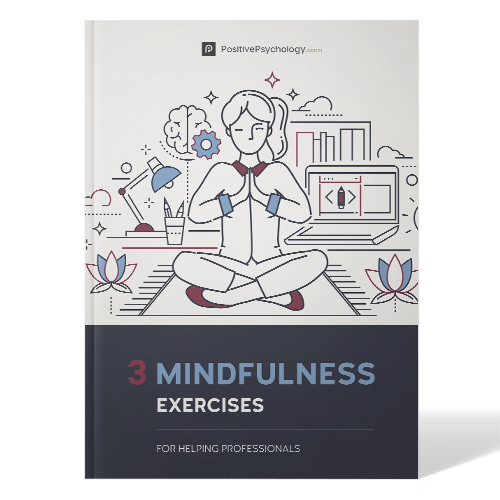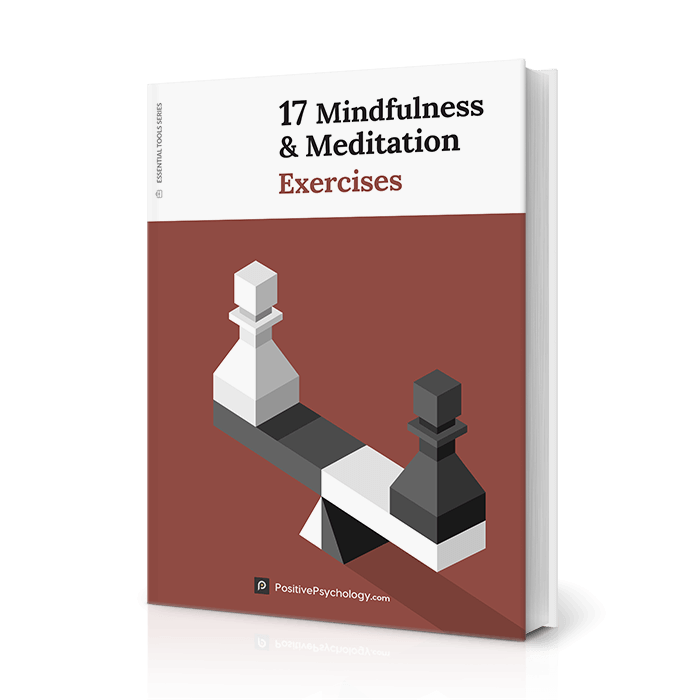How to Practice Mindfulness: 11 Practical Steps and Tips
 Have you ever wanted to bring more mindfulness into your life, but struggle to make time in your chaotic schedule?
Have you ever wanted to bring more mindfulness into your life, but struggle to make time in your chaotic schedule?
Or do you set the intention to go about your day more mindfully, only to fall into the trap of snacking unconsciously or responding to emails on autopilot?
It’s not easy in the beginning, and there will be bumps along the path toward a committed mindfulness practice.
This article will guide you through various ways and resources to help introduce mindfulness in your life so that you are well prepared to start your journey.
Before you read on, we thought you might like to download our three Mindfulness Exercises for free. These science-based comprehensive exercises will not only help you cultivate a sense of inner peace throughout your daily life, but also give you the tools to enhance the mindfulness of your clients, students, children, or employees.
This Article Contains:
- How to Begin Practicing Mindfulness
- 5 Reasons to Start Practicing Mindfulness Today
- Steps for a Mindful Daily Life
- 2 Useful PDFs for the Classroom
- 6 Tips for Being Mindful in the Workplace
- How to Use Mindfulness for Stress and Anxiety
- Top Strategies for a Mindful Classroom
- 2 Ways to Combine Mindfulness and Gratitude
- Our Favorite Mindfulness Videos
- How Can Mindfulness-X Help You?
- A Take-Home Message
- References
How to Begin Practicing Mindfulness
If you are a complete beginner to mindfulness, I’d recommend our article What Is Mindfulness?, which includes a full definition and lists significant benefits of mindfulness.
At its core, mindfulness is an activity that needs to be practiced regularly and with intention. With these cornerstones in mind, let’s consider a few ways to introduce mindfulness into our daily lives.
Start with a daily routine
The first step is to introduce a daily routine. Like any exercise, mindfulness benefits from regular practice. Researchers often use a mindfulness intervention plan that takes place across many weeks (Mackenzie, Poulin, & Seidman-Carlson, 2006; Hofmann, Sawyer, Witt, & Oh, 2010).
Decide on an uninterrupted time of day that you can set aside to practice mindfulness, and keep that time in your schedule.
Mindfulness is a way of perceiving, thinking, and behaving
You would be forgiven for thinking that mindfulness is just an activity; in fact, mindfulness is a way of perceiving and observing, and it can be developed using various tools. Some of these tools include meditation, exercises, and breathing.
Commit, commit, commit
The most important step before embarking on this journey is to commit to it. Some meta-analyses have highlighted varying effects for mindfulness interventions, and the authors posit that this might be because the participants are not engaging in their mindfulness homework exercises or engaging for too short a period to see results (Khoury et al., 2013).
Knowing this, before you begin, you have to commit. Next, we’ll explore why you should start a mindfulness routine and how to live a mindful daily life.
5 Reasons to Start Practicing Mindfulness Today

Beginning a mindfulness habit is work, and it will be difficult in the beginning, but this habit will become easier over time and with more practice.
Additionally, mindfulness has numerous positive benefits (Davis & Hayes, 2011). The benefits of mindfulness are emotional, cognitive, interpersonal, professional, and practical.
Emotional benefits
Regular mindfulness meditation results in reduced depressive symptoms, negative affect, and rumination (Chambers, Lo, & Allen, 2008; Hofmann et al., 2010; Khoury et al., 2013). Rumination is persistent worrying about the following:
- Past events
- Negative emotions
- The causes and consequences of these emotions (Nolen-Hoeksema, 2000)
Rumination is often linked to increased depression and anxiety (Nolen-Hoeksema, 2000). Read our related article on Mindful Thinking, where we discuss four ways to stop ruminating.
The positive effects of mindfulness at reducing negative affect and other conditions like depression and anxiety are not limited to only one study. These findings are also supported in a meta-analysis by Hofmann et al. (2010).
In that meta-analysis, which contained 39 studies, the effect sizes for the differences in the psychological state before and after the mindful therapy were large for clinical participants and moderate for nonclinical participants.
These results suggest that therapeutic interventions based on mindfulness are not only successful for clinical populations, but the benefits extend to nonclinical populations.
Cognitive benefits
Practitioners of mindfulness have better working memory than nonpractitioners (Chambers et al., 2008; Corcoran, Farb, Anderson, & Segal, 2010), which allows for better emotional regulation.
Participants also report that their attention improves significantly after regular mindful meditation compared to before they began mindful meditation (Chambers et al., 2008).
There is also some laboratory evidence that suggests that people who have a longer mindfulness habit are better at ignoring emotional distractions than people whose mindfulness habit is shorter and those who do not practice at all (Pavlov et al., 2015).
These results suggest that the benefits of mindfulness are cumulative and will continue to improve over time.
Interpersonal benefits
The benefits of mindfulness flow to other spheres of life, including relationships.
There is some evidence that regular mindfulness practice can improve relationship satisfaction and communication through a variety of paths (Barnes, Brown, Krusemark, Campbell, & Rogge, 2007), specifically:
- Responding to relationship stress in a positive way
- Better identification of one’s own emotions
- Better communication of one’s own emotions
- Better conflict resolution
- Improved empathy
Professional benefits
It should come as no surprise that the benefits of mindfulness are not limited to interpersonal relationships. For example, the ability to communicate clearly and respond more effectively to stressful situations should translate from personal to professional contexts (Dekeyser, Raes, Leijssen, Leyson, & Dewulf, 2008).
Employees who practice regular mindful activities experienced higher job satisfaction and lower job stress than a control group who did not participate (Hülsheger, Alberts, Feinholdt, & Lang, 2012).
Practical reasons for practicing mindfulness
The final reason to practice mindfulness is a practical one. Methods to improve mindfulness are often easy and inexpensive. The only ‘cost’ is that of time and effort.
Steps for a Mindful Daily Life
Although mindfulness is fostered through regular practice, it is also extremely important to try to incorporate mindfulness into all aspects of your life.
It can be difficult, but we’ve made a list of steps to help:
Make the time
Set aside time each day that you can formally practice mindfulness. Ideally, this daily slot should occur at the same time each day and for the same duration so that it becomes a habit (Khoury et al., 2013).
Studies that have used a mindfulness intervention have done so over several weeks, with one or two sessions each day. Sometimes interventions are only five days a week (Mackenzie et al., 2006), and sometimes they are six days a week (Parsons, Crane, Parsons, Fjorback, & Kuyken, 2017). The length of each session varies between 10 minutes (Mackenzie et al., 2006) and 45 minutes (Kabat-Zinn, 1990).
Perform an exercise
During the time that you have set aside, perform one of the following exercises (Davis & Hayes, 2011): a body scan, deep breathing, or mindful meditation.
- Body scan: During the body scan exercise, try to focus inwardly on your body and the way that it feels. Your task is to develop an awareness of sensations in your body. Breathe deeply, and remain aware of your bodily sensations without trying to change them.
- Three-minute breathing: During this exercise, the participant is guided through three points where they become aware, focus their attention on their breathing, and extend their attention. Focusing on one’s breath is meant to act as an anchor.
- Mindful stretching: For this exercise, start by following one of the mindful stretching videos listed below. While in the stretch, focus on your breathing, and think about how your body feels. Try to focus only on the activity of stretching and avoid other distracting thoughts.
- Mindful breathing while focusing on your breath: Sit somewhere quiet in a seated position. While seated, focus on your breathing. Inhale deeply for three seconds and slowly exhale for three seconds. Use your breath as your anchor; when you find your thoughts wandering, come back to your breath and inhale deeply for three seconds, followed by a deep exhalation for three seconds. In many exercises, the time limit for this exercise is three minutes.
- Mindful meditation: This is a particular type of meditation where you learn how to practice mindfulness. During this type of meditation, you will be seated for 10–30 minutes and practice focusing on only your breathing. This is very similar to the previous two exercises, except that your body is not moving, and the time is longer.
Act mindfully
Choose one activity during the day that you will perform in a mindful way, that is, with complete awareness. The best type of activity is one that would usually be done automatically; for example, driving, showering, cooking, eating, exercising, or walking. Here is an example of how to act mindfully while eating.
Mindful eating: When you take your lunch break, practice mindful eating. Do not rush through your lunch so that you can get back to your desk. Instead, take the time to enjoy your lunch. Focus on the texture of your meal, the effort that went into making it, and the flavors of the food in your mouth.
Actively reflect on how eating your lunch makes you feel. Are there any ingredients in your meal that you especially enjoy?
2 Useful PDFs for the Classroom
If you are interested in introducing mindfulness into the classroom but don’t know where to begin, Teaching Kids to Thrive will provide you with more information that is classroom specific.
Mindful Classrooms is also an excellent, detailed guide for introducing mindfulness exercises into the classroom. It belongs in every teacher’s top drawer.
6 Tips for Being Mindful in the Workplace
The workplace presents unique challenges.
- In our workplace, we often have to deal with strangers. Because we do not know them, we might misinterpret what they say. Furthermore, there is an unspoken rule of conduct about how we should behave in the workplace.
- A workplace hierarchy with a structured set of rules and codes influences our behavior.
- Some of the emotions we deal with may be deemed inappropriate for the workplace.
- We may work in a high-stress environment where we have to make decisions with severe consequences.
For example, certain types of behaviors and emotional responses toward a client are inappropriate and can cause employees emotional distress. We may have to sit stoically through an uncomfortable/unfair reprimand or restrain our disapproval of company decisions.
We often have to ‘keep calm.’ Being able to implement mindfulness in the workplace can be the solution when facing these challenges.
Here are some tips and interventions for mindfulness at work.
Tip one: Use a metacognitive strategy
In situations that would typically provoke you, try the following three steps.
- ‘Step away’ mentally from the situation.
- Experience the situation.
- Do not evaluate the situation.
Specifically, try to look in on your thoughts and feelings without reworking the narrative of the situation (e.g., “But he placed the wrong order” or “I’m trying my best without support”). By adopting a meta-stance (Hülsheger et al., 2012), you can observe the situation without reacting to it.
Tip two: Acknowledge your feelings
The above technique is also useful during periods of stress or panic, especially when a deadline is looming. Try to step away from yourself mentally and observe your feelings and thoughts.
The intention is not to react to the anxiety but to recognize it, acknowledge it, and disengage from it. Try to avoid forming a cognitive narrative where you judge your feelings and behavior.
Tip three: Mindful listening
Up to this point, both tips have been focused inward by examining your thoughts and feelings. However, these techniques can also be focused outward.
For example, when talking to a client or a colleague, try to listen to what they are saying in its entirety before beginning to formulate a response. Try to adopt the same meta-stance that you would have taken toward yourself and adjust it toward them. This might help you to respond to their messages in a nonreactive manner.
Tip four: Mindfulness exercises
Continue to practice mindfulness exercises at your desk at various points during the day.
- Before beginning your workday, perform a one-minute mindfulness task at your desk. Set a timer for 60 seconds, and spend that minute with your eyes closed, practicing a few mindfulness techniques such as breathing mindfully or reflecting on your thoughts.
- At various points during the day, you can implement a three-minute breathing exercise. Set a timer for three minutes and practice deep exhalation and inhalation exercises.
- Other useful exercises include mindful walking, mindful eating, and a body scan.
Tip five: Avoid judgment
Ultimately, tips 1 and 2 relate to awareness of your thoughts and feelings without judgment.
Awareness is not the same as stoicism; the intention is not to repress your feelings. You will experience feelings. You are human and you must feel, but try to avoid the feedback loop that normally further encourages negative thinking.
Tip six: Introduce a breathing exercise before a meeting
Up to this point, most of the tips have focused on the role and experiences of the employee; however, there is no reason why everyone in a team should not practice a mindfulness exercise.
There is some preliminary evidence that introducing a three-minute breathing exercise before a stand-up meeting results in better decision making, more productive meetings, better listening, good interactions, and more appropriate emotional responses (den Heijer, Koole, & Stettina, 2017).
This exercise could be completed as a group or individually before the meeting.
How to Use Mindfulness for Stress and Anxiety
Earlier in this post, we touched on the relationship between anxiety, depression, and rumination.
Mindfulness is a very useful tool for combatting anxiety and stress, which in turn can reduce symptoms of depression (Brady & Kendall, 1992). The positive effect of mindfulness as a therapeutic intervention for anxiety and depression has been confirmed through a meta-analysis (Khoury et al., 2013).
Mindfulness-based stress reduction program
There are numerous ways that mindfulness can be used to target anxiety. One such way is the mindfulness-based stress reduction program, which was first created by Kabat-Zinn (1990).
This program is a collection of exercises and tools that can be applied in everyday life. Some of these exercises and tools include:
- Breath-focused attention
- Body scan
- Isolating and paying attention to each sense
- Walking meditation
- Eating meditation
These exercises and tools are a very important contribution to therapeutic interventions in psychology. Since Kabat-Zinn (1990) first developed the program, some of the tools and exercises that make up the program are also suggested as standalone exercises that can be performed at any time of the day and in any context.
For example, if you are feeling very anxious or stressed, try implementing any of these short exercises:
- Take a short break to practice a three-minute breathing exercise where you use your breath as your anchor. Make sure to take a deep inhalation for three seconds, followed by a deep exhalation for three seconds.
- Put aside a minute and practice mindful thinking. Sit in a quiet place, and try to step away from your feelings, observing your thoughts and behaviors. Do not judge your behavior; your intention is only to observe it.
These two techniques can help you during periods of acute stress, but a more powerful device would be to foster a mindfulness habit now (when you are not stressed) so that you are less vulnerable in the future.
Top Strategies for a Mindful Classroom

To help you, we have summarized various methods that you can use as inspiration for introducing mindfulness in the classroom.
A quiet place
This exercise is more appropriate for younger children under the age of 10. In the classroom, introduce the concept of a Quiet Place. A Quiet Place is a place that children can access with their eyes open or closed, and in any environment.
This exercise is meant to help children find a place of solitude where they can collect their thoughts and practice deep breathing. I’ve adapted the instructions from Saltzman (n.d.):
Today we are going to learn about a Quiet Place. This place is inside you, and you can go there just by breathing. To start, take some long, slow breaths. This is a good place to go to if you are feeling angry or sad, and it is a good place to talk about your feelings. When you go to your Quiet Place inside of you, you will find that your feelings are not very big. You can go there whenever you want and stay for however long you want.
Mindfulness through breathing exercises
Mindfulness is often taught with breathing techniques that use the breath as the anchor.
Asking children to ‘ground’ themselves with breathing might be too abstract a concept; instead, you could guide them through a calm, relaxed breathing exercise where they inhale for three seconds and then slowly exhale for three seconds.
Using imagery might help children to better understand a deep belly breath. To help illustrate, you could use a balloon as an example. Once the children know how to perform these deep breathing exercises, you can introduce this technique before stressful events (like a test) or if two children fight.
PEACE
This exercise might work better for slightly older children over the age of 10.
The idea is that children are introduced to the PEACE concept (adapted from Saltzman, n.d.). Each letter in the acronym represents a different action. Children are taught that when they want to respond to a particular situation, they must perform each action that corresponds to each letter.
| Actions | Descriptions |
|---|---|
| Pause | Before responding, children must pause. |
| Exhale | Children must exhale mindfully, and then inhale. They must practice exhaling and inhaling before moving to the next step. |
| Acknowledge/accept/allow | They must learn to acknowledge the situation. Acknowledgment shouldn’t be confused with ‘be happy’ or ‘hide emotions.’ Children must be made aware that they will still feel their emotions, and they must accept their emotions. After accepting their emotions, children are encouraged to visit the Quiet Place and allow the experience of their emotions. |
| Choose | After spending some time feeling their emotions, children must choose how to respond to the situation. |
| Engage | After deciding how to respond, children are ready to engage with the people in the situation and enact their selected responses. |
Yoga in the classroom
Introducing a yoga session in the classroom could be a very useful way to introduce mindfulness. By linking yoga poses with animal names, children might find it easier to play along.
Many of the yoga poses already correspond with animals (e.g., cat pose, cow pose, downward-facing dog), and with some creative thinking, other poses could be renamed as animals (e.g., balasana, or child’s pose, could be a turtle).
Consider putting aside time before recess or the end of the school day to do 10 minutes of yoga with the children. During this period, also encourage children to breathe deeply or go to their Quiet Place during the pose.
2 Ways to Combine Mindfulness and Gratitude
Mindfulness and gratitude are two tools that work well together. Mindfulness encourages us to focus on the present in a nonjudgmental way, and gratitude encourages us to appreciate things that bring us joy. To foster a habit of experiencing gratitude, we first need to perceive what we are grateful for. To do this, we need to make the time.
One way to combine mindfulness and gratitude is through gratitude journaling. Every day, spend a short period writing down a list of things you are grateful for. This list can include material things, people, thoughts, experiences, or anything else that you can think of.
When writing down the list, spend extra time explaining why you are grateful for that experience and how it made you feel. Do not go overboard – a short sentence will do – but aim to deepen your experience of how you perceived this event.
Another option is to incorporate active gratitude into your mindfulness exercises. For example, mindfulness can help us to perceive negative experiences in a nonjudgmental way.
We can take this experience one step further by incorporating a gratitude element. In a way, we are finding a silver lining in that experience. The intention is not to downplay your feelings of a negative experience; instead where possible, find opportunities for gratitude.
| Negative experience | Active gratitude |
|---|---|
| I am terrified about the job interview. I am so nervous. | I am grateful to present my skills to people I admire. |
| I am worried that I might not finish my work by the deadline. | I am grateful to show what I can produce when I work hard. |
| I am afraid that my partner will think that my feelings are unimportant. | I am grateful that I have a partner with whom I can share my innermost feelings. |
| I am sad about my father passing away. | I am grateful for all the memories I have of him. |
Our Favorite Mindfulness Videos
To help you start your mindfulness journey, we have put together a list of videos. Some can also be used in the classroom.
Mindfulness meditation
Daily Calm | 10 Minute Mindfulness Meditation | Be Present
Mindfulness Meditation – Guided 10 Minutes
If you enjoy these videos, consider subscribing to the Calm channel on YouTube.
Mindful yoga
Yoga for Mindfulness | 15-Minute Yoga
Mindful Yoga Flow | 40 Minutes – Full Body Stretch
Mindful stretching
Mindful Movement 10 Minute Seated Yoga Stretch
Mindful Stretch | 30 Minute Mindful Stretching for Pain, Anxiety, & Stress
Body scan
Body Scan Meditation (Tame Anxiety)
Three-minute breathing exercise
The Three Minute Breathing Space
Videos for children
Mindfulness Meditation for Kids | Breathing Exercise | Guided Meditation for Children
Breath Meditation for Kids | Mindfulness for Kids
Be the Pond | Cosmic Kids Zen Den – Mindfulness for kids
Further interest
All it takes is 10 mindful minutes | Andy Puddicombe
Mindful Work | David Gelles | Talks at Google
How Can Mindfulness-X Help You?
At PositivePsychology.com, we have several resources that help you start your mindfulness habit.
Our most valuable resource is the Mindfulness-X course, which will help you further develop your mindfulness skills.
The course is a mixture of theory and practice. You’ll learn a lot more about mindfulness and the scientific evidence that supports its positive effects, but you’ll also learn about different ways to use mindfulness as a tool in your own life and the lives of your clients.
The entire course is online, so you can easily complete it from your home or your office, regardless of where you are based. In total, there are eight lessons, all of which are grounded in scientific research. If you want more information, check out this article about Dr. Alberts and Mindfulness-X.
A Take-Home Message
You’ve taken the first step toward adopting mindfulness by reading this post.
We hope that by now you’re convinced of the numerous benefits of practicing mindfulness and have a few ideas on how to implement it in your everyday life.
Most importantly, remember that mindfulness is a way of thinking that you are capable of practicing throughout your day. It is not limited to only one exercise, it is not limited to only three minutes, and it is not a switch that you can turn on and off.
With time and regular practice, you will start to practice mindfulness more easily in all activities, and you will see the benefits. Mindfulness is appropriate for people of all ages and in multiple contexts.
For further reading, here are some recommended posts:
History of Mindfulness: From East to West and Religion to Science
Top 50 Best Mindfulness Books (Reviews + PDFs)
76 Most Powerful Mindfulness Quotes: Your Daily Dose of Inspiration
We hope you enjoyed reading this article. Don’t forget to download our three Mindfulness Exercises for free.
- Barnes, S., Brown, K. W., Krusemark, E., Campbell, W. K., & Rogge, R. D. (2007). The role of mindfulness in romantic relationship satisfaction and responses to relationship stress. Journal of Marital and Family Therapy, 33, 482-500.
- Brady, E. U., & Kendall, P. C. (1992). Comorbidity of anxiety and depression in children and adolescents. Psychological Bulletin, 111(2), 244-255.
- Chambers, R., Lo, B. C. Y., & Allen, N. B. (2008). The impact of intensive mindfulness training on attentional control, cognitive style, and affect. Cognitive Therapy and Research, 32, 303-322.
- Corcoran, K. M., Farb, N., Anderson, A., & Segal, Z. V. (2010). Mindfulness and emotion regulation: Outcomes and possible mediating mechanisms. In A. M. Kring & D. M. Sloan (Eds.), Emotion regulation, and psychopathology: A transdiagnostic approach to etiology and treatment (pp. 339-355). Guilford Press.
- Davis, D. M., & Hayes, J. A. (2011). What are the benefits of mindfulness? A practice review of psychotherapy-related research. Psychotherapy, 48(2), 198-208.
- Dekeyser, M., Raes, F., Leijssen, M., Leyson, S., & Dewulf, D. (2008). Mindfulness skills and interpersonal behavior. Personality and Individual Differences, 44, 1235-1245.
- Den Heijer, P., Koole, W., & Stettina, C. J. (2017, May). Don’t forget to breathe: A controlled trial of mindfulness practices in agile project teams. In International Conference on Agile Software Development (pp. 103-118). Springer.
- Hofmann, S. G., Sawyer, A. T., Witt, A. A., & Oh, D. (2010). The effect of mindfulness-based therapy on anxiety and depression: A meta-analytic review. Journal of Consulting and Clinical Psychology, 78(2), 169-183.
- Hülsheger, U. R., Alberts, H. J., Feinholdt, A., & Lang, J. W. (2013). Benefits of mindfulness at work: The role of mindfulness in emotion regulation, emotional exhaustion, and job satisfaction. Journal of Applied Psychology, 98(2), 310-325.
- Kabat-Zinn, J. (1990). Full catastrophe living: Using the wisdom of your body and mind to face stress, pain, and illness. Delta.
- Khoury, B., Lecomte, T., Fortin, G., Masse, M., Therien, P., Bouchard, V., … Hofmann, S. G. (2013). Mindfulness-based therapy: A comprehensive meta-analysis. Clinical Psychology Review, 33(6), 763-771.
- Mackenzie, C. S., Poulin, P. A., & Seidman-Carlson, R. (2006). A brief mindfulness-based stress reduction intervention for nurses and nurse aides. Applied Nursing Research, 19(2), 105-109.
- Nolen-Hoeksema, S. (2000). The role of rumination in depressive disorders and mixed anxiety/depressive symptoms. Journal of Abnormal Psychology, 109(3), 504-511.
- Parsons, C. E., Crane, C., Parsons, L. J., Fjorback, L. O., & Kuyken, W. (2017). Home practice in mindfulness-based cognitive therapy and mindfulness-based stress reduction: A systematic review and meta-analysis of participants’ mindfulness practice and its association with outcomes. Behaviour Research and Therapy, 95(2), 29-41.
- Pavlov, S. V., Korenyok, V. V., Reva, N. V., Tumyalis, A. V., Loktev, K. V., & Aftanas, L. I. (2015). Effects of long-term meditation practice on attentional biases towards emotional faces: An eye-tracking study. Cognition and Emotion, 29(5), 807-815.
- Saltzman, A. (n.d.). Mindfulness: A guide for teachers. Retrieved from http://karlheardmeditation.co.uk/documents/Mindfulness-A_Teachers_Guide.pdf
Let us know your thoughts
Read other articles by their category
- Body & Brain (49)
- Coaching & Application (57)
- Compassion (26)
- Counseling (51)
- Emotional Intelligence (24)
- Gratitude (18)
- Grief & Bereavement (21)
- Happiness & SWB (40)
- Meaning & Values (26)
- Meditation (20)
- Mindfulness (45)
- Motivation & Goals (45)
- Optimism & Mindset (34)
- Positive CBT (28)
- Positive Communication (20)
- Positive Education (47)
- Positive Emotions (32)
- Positive Leadership (18)
- Positive Parenting (4)
- Positive Psychology (33)
- Positive Workplace (37)
- Productivity (16)
- Relationships (46)
- Resilience & Coping (36)
- Self Awareness (21)
- Self Esteem (38)
- Strengths & Virtues (31)
- Stress & Burnout Prevention (34)
- Theory & Books (46)
- Therapy Exercises (37)
- Types of Therapy (64)





What our readers think
I’m led to believe that mindfulness re your thoughts, is to simply observe them.
I observe my thoughts, and process them, I question the benefits of, if positive I react in like way, if negative I fail to react at all.
Is such application actually mindfulness, or is it my definition of?
Hi Tim,
Sounds like you’re on the right track. One point that I’d highlight is a component of the definition of mindfulness by Jon Kabat-Zinn: “mindfulness means paying attention in a particular way: on purpose, in the present moment, and without judgment.”
Perhaps you can experiment with not even attempting to process, question, or react to the thoughts you notice arising. This may help you to practice this third component of ‘non-judgment’.
See how you go!
– Nicole | Community Manager